Coldkennels
Barnack-toting Brit.
Does anyone happen to know how exactly the flash circuit works in a late model Leotax - or even any clear photos of the layout with the top plate removed? I can't find any disassembly photos anywhere, just the 360p video Daitocamera posted years ago on Youtube.
The flash has never worked in this T2L "Elite" since I bought it a few years back, and while a "repair guy" replaced the PC socket during a shutter tune-up, he still didn't get the flash working.
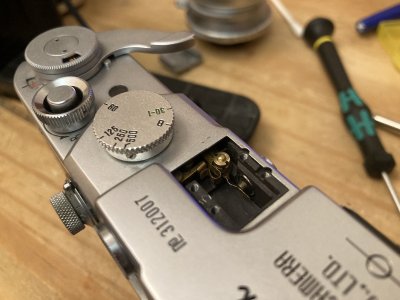
Best I can tell without removing the top plate completely is that the arm shown closest to the shutter dial slaps into the thin curved contact to complete the circuit when the shutter is fired, but for some reason there's no continuity between that curved contact and the flat contact touching the back of the PC socket on this camera - instead it's somehow connected to that aforementioned arm even when the two parts aren't touching, regardless of the state of the shutter.
Honestly, I don't use flash that often, but it's bloody annoying that it's not an option at all with this thing right now. I'd like to get it working if I can.
The flash has never worked in this T2L "Elite" since I bought it a few years back, and while a "repair guy" replaced the PC socket during a shutter tune-up, he still didn't get the flash working.

Best I can tell without removing the top plate completely is that the arm shown closest to the shutter dial slaps into the thin curved contact to complete the circuit when the shutter is fired, but for some reason there's no continuity between that curved contact and the flat contact touching the back of the PC socket on this camera - instead it's somehow connected to that aforementioned arm even when the two parts aren't touching, regardless of the state of the shutter.
Honestly, I don't use flash that often, but it's bloody annoying that it's not an option at all with this thing right now. I'd like to get it working if I can.
Coldkennels
Barnack-toting Brit.
Well, as no one replied to this in the last month, I did some digging and probing with a multimeter, and figured I should document the problem and the fix in case anyone else stumbles upon this with the same problem in the future.
First, let's look at what you can see by removing the accessory shoe:
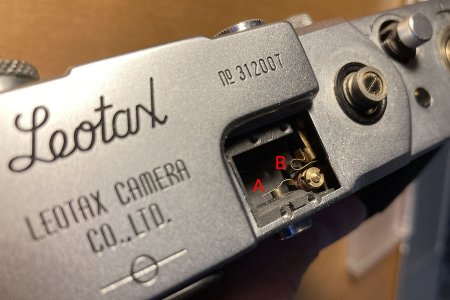
As you can see, the back of the PC port contacts a brass plate we'll call A. I can't remember which way round a PC socket is wired (centre pin = positive?), but the other part of the socket is connected to the body, which becomes part of the circuit. That bent piece of brass, B, is what should be used to complete the circuit, but something wasn't working.
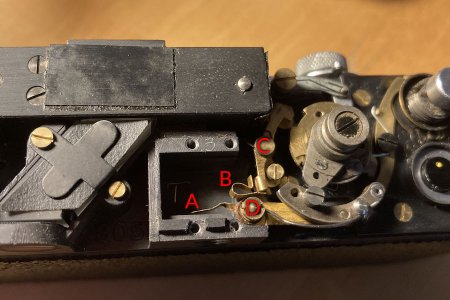
Removing the top plate we get a clearer look at the mechanism. The shutter's no different to any other Leica-derived camera, but as the shutter fires, it knocks into arm C, which is pushed out to make contact with B, completing the circuit and firing the flash when everything else is working correctly. The weird thing is that A and B should be connected, and both are mounted on column D, but there's something isolating them from each other on that column for some reason.
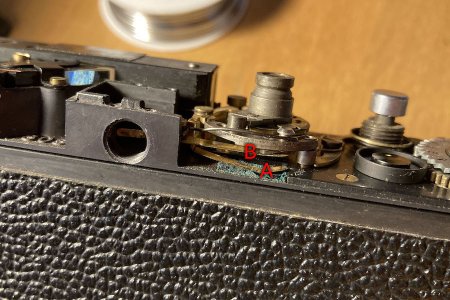
A side view shows that A and B extend outwards past column D, and A is bent up at the end, with B resting underneath the arm above while isolated from it with a small block of... something (I didn't check what it was. Derp).
The catch is that A also has to be isolated from the body, otherwise the circuit is always closed, and so a pad of some form was obviously placed underneath it to keep it away from the body and in close proximity to the section of part B, so that when the shutter button is pressed, part B is pushed down by the arm above onto part A in preparation for the arm C shown in the previous photo to close the circuit. Obviously, on my Leotax, whatever that pad under part A was has long since degraded into nothingness. Not only did that mean A and B could no longer make contact, but A was close enough to the body for electricity to arc from the end of it when a fully-charged flash was connected. Not good.
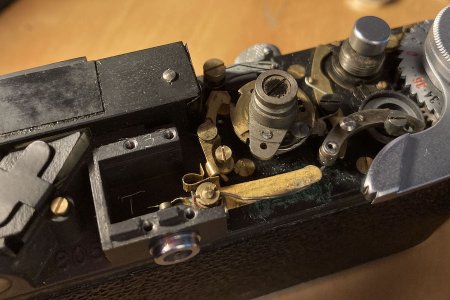
Thankfully, it's a simple fix - although levering everything out the way to get access to clean off the corroded and degraded pad was fiddly work. I could have probably dismantled column D, but this was definitely the simpler option.
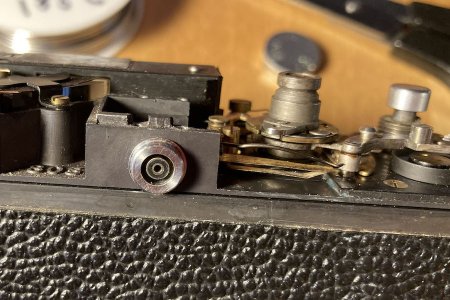
After some scraping with matchsticks and rubbing with alcohol soaked q-tips, the pad is a lot cleaner - and, as a bonus, hooking the two brass plates under the spring has "encouraged" part A to come up and make contact with part B of its own accord.
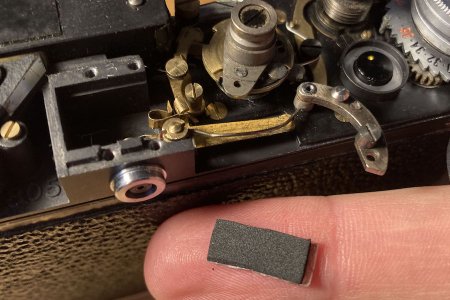
To keep it that way, I cut a small piece of 2mm thick adhesive-backed closed cell foam from a light sealing kit. The space in the body where the isolation material/pad was originally located measures 7mm x 16mm, but I cut this slightly shorter to make it easier to manoeuvre under the brass plates. It only has to be at the right hand side, really.
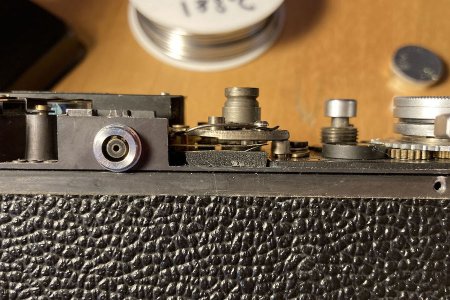
With the 2mm thick replacement pad in place, part A sits slightly higher than originally intended, but I figure that just leaves a bit of leeway for the pad to be compressed over time before it needs replacing again. Either way, the flash now fires perfectly fine. Success.
Hopefully this helps someone, but I will say one word of warning: taking the top plate off one of these late Leotax models is easy, but that knob rewind is an utter nightmare to rebuild. I spent the best part of an hour swearing at springs while I tried to figure out the best way to fit it back together.
Also: there is a tiny ball bearing in the film speed reminder on top of the winding lever. Be careful not to lose it (like the UK-based camera tech did who CLA'd this Leotax two years ago did). It's 1mm in diameter if you need to replace it.
First, let's look at what you can see by removing the accessory shoe:

As you can see, the back of the PC port contacts a brass plate we'll call A. I can't remember which way round a PC socket is wired (centre pin = positive?), but the other part of the socket is connected to the body, which becomes part of the circuit. That bent piece of brass, B, is what should be used to complete the circuit, but something wasn't working.

Removing the top plate we get a clearer look at the mechanism. The shutter's no different to any other Leica-derived camera, but as the shutter fires, it knocks into arm C, which is pushed out to make contact with B, completing the circuit and firing the flash when everything else is working correctly. The weird thing is that A and B should be connected, and both are mounted on column D, but there's something isolating them from each other on that column for some reason.

A side view shows that A and B extend outwards past column D, and A is bent up at the end, with B resting underneath the arm above while isolated from it with a small block of... something (I didn't check what it was. Derp).
The catch is that A also has to be isolated from the body, otherwise the circuit is always closed, and so a pad of some form was obviously placed underneath it to keep it away from the body and in close proximity to the section of part B, so that when the shutter button is pressed, part B is pushed down by the arm above onto part A in preparation for the arm C shown in the previous photo to close the circuit. Obviously, on my Leotax, whatever that pad under part A was has long since degraded into nothingness. Not only did that mean A and B could no longer make contact, but A was close enough to the body for electricity to arc from the end of it when a fully-charged flash was connected. Not good.

Thankfully, it's a simple fix - although levering everything out the way to get access to clean off the corroded and degraded pad was fiddly work. I could have probably dismantled column D, but this was definitely the simpler option.

After some scraping with matchsticks and rubbing with alcohol soaked q-tips, the pad is a lot cleaner - and, as a bonus, hooking the two brass plates under the spring has "encouraged" part A to come up and make contact with part B of its own accord.

To keep it that way, I cut a small piece of 2mm thick adhesive-backed closed cell foam from a light sealing kit. The space in the body where the isolation material/pad was originally located measures 7mm x 16mm, but I cut this slightly shorter to make it easier to manoeuvre under the brass plates. It only has to be at the right hand side, really.

With the 2mm thick replacement pad in place, part A sits slightly higher than originally intended, but I figure that just leaves a bit of leeway for the pad to be compressed over time before it needs replacing again. Either way, the flash now fires perfectly fine. Success.
Hopefully this helps someone, but I will say one word of warning: taking the top plate off one of these late Leotax models is easy, but that knob rewind is an utter nightmare to rebuild. I spent the best part of an hour swearing at springs while I tried to figure out the best way to fit it back together.
Also: there is a tiny ball bearing in the film speed reminder on top of the winding lever. Be careful not to lose it (like the UK-based camera tech did who CLA'd this Leotax two years ago did). It's 1mm in diameter if you need to replace it.
Zuiko-logist
Well-known
I don’t own a Leotax, but thank you for doing this! Very interesting.
owen3f
Newbie
I'm trying to get the top plate off a Leotax Elite to get at a shutter problem, but I am stuck with the shutter release button not letting go.Does anyone happen to know how exactly the flash circuit works in a late model Leotax - or even any clear photos of the layout with the top plate removed? I can't find any disassembly photos anywhere, just the 360p video Daitocamera posted years ago on Youtube.
The flash has never worked in this T2L "Elite" since I bought it a few years back, and while a "repair guy" replaced the PC socket during a shutter tune-up, he still didn't get the flash working.
View attachment 4817459
Best I can tell without removing the top plate completely is that the arm shown closest to the shutter dial slaps into the thin curved contact to complete the circuit when the shutter is fired, but for some reason there's no continuity between that curved contact and the flat contact touching the back of the PC socket on this camera - instead it's somehow connected to that aforementioned arm even when the two parts aren't touching, regardless of the state of the shutter.
Honestly, I don't use flash that often, but it's bloody annoying that it's not an option at all with this thing right now. I'd like to get it working if I can.
There must be something I'm missing...........what's the trick here? Thanks in advance....Owen
David Murphy
Mentor
I don't know if the Elite is similar enough to the Leica II/III series for the Hakosyn synchronizer to work, but if so that could be a possible work-around. I've used one on a Leica IIIc in recent years with excellent results.
David Murphy
Mentor
Or maybe it was the Geiss Kontakt synchronizer, I can't remember - I think they are similar
Coldkennels
Barnack-toting Brit.
Do you mean the collar around the shutter release - the one that flicks the camera between advance and rewind? Because yep, that thing can be STIFF.I'm trying to get the top plate off a Leotax Elite to get at a shutter problem, but I am stuck with the shutter release button not letting go.
There must be something I'm missing...........what's the trick here? Thanks in advance....Owen
It's a simple right-hand thread; just set it to the R position and then keep twisting. It'll give eventually.
The big problem I'm having with mine now is that the lever wind doesn't seem to operating correctly; if you let go of it once it completes the full stroke, it doesn't return to the starting position, instead resting perpendicular to the camera body. Winding from there isn't enough to complete a full stroke and advance the shutter fully, so you have to either double-stroke or return the advance lever to the proper starting position manually for every frame. It's really annoying.
David Murphy
Mentor
I mean this gadget (and one or two others like it):
This basically adds an external strobe switch. The question is whether or not the geometry between the cold shoe and the shutter dial on the Elite would permit its use. I have used these on older Leotaxes that were truer to the Leica II/III standard.
Geiss-Kontakt Synchronizer for Leica 珍品! [Z7821885850] - 7,500円(税込) :
Geiss-Kontakt Synchronizer for Leica 珍品! [Z7821885850] - 商品詳細ドイツ製 Geiss-Kontakt Synchronizer for Leica 付属品 純正ケース 取扱説明書となります。バルナックライカ用のフラッシュシンクロ...
otvfut.bioseby.shop
This basically adds an external strobe switch. The question is whether or not the geometry between the cold shoe and the shutter dial on the Elite would permit its use. I have used these on older Leotaxes that were truer to the Leica II/III standard.
owen3f
Newbie
Thanks - it worked!Do you mean the collar around the shutter release - the one that flicks the camera between advance and rewind? Because yep, that thing can be STIFF.
It's a simple right-hand thread; just set it to the R position and then keep twisting. It'll give eventually.
The big problem I'm having with mine now is that the lever wind doesn't seem to operating correctly; if you let go of it once it completes the full stroke, it doesn't return to the starting position, instead resting perpendicular to the camera body. Winding from there isn't enough to complete a full stroke and advance the shutter fully, so you have to either double-stroke or return the advance lever to the proper starting position manually for every frame. It's really annoying.
Share:
-
This site uses cookies to help personalise content, tailor your experience and to keep you logged in if you register.
By continuing to use this site, you are consenting to our use of cookies.
